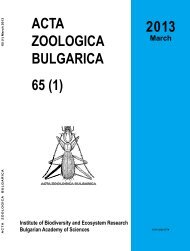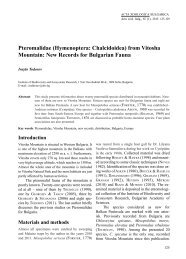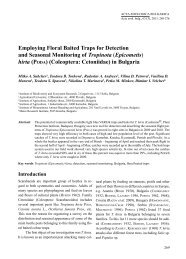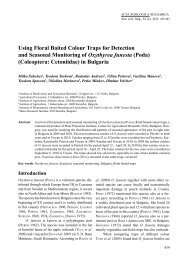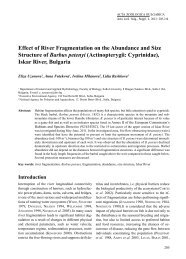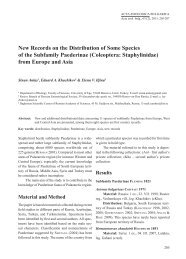widespread
supplement-3-041-054.. - Acta zoologica bulgarica
supplement-3-041-054.. - Acta zoologica bulgarica
- No tags were found...
You also want an ePaper? Increase the reach of your titles
YUMPU automatically turns print PDFs into web optimized ePapers that Google loves.
ACTA ZOOLOGICA BULGARICAActa zool. bulg., Suppl. 3, 2011: 41-54Increase of the Population of the Eastern Imperial Eagle(Aquila heliaca) in BulgariaDimitar A. Demerdzhiev 1 , Gradimir Zh. Gradev 2 , Stoycho A. Stoychev 3 , Ivelin I. Ivanov 4 ,Tzeno Hr. Petrov 5 and Simeon A. Marin 4131 Bulgaria Blvd., 4230 Asenovgrad, Bulgaria; E-mail: d_demerdzhiev@abv.bg; www.bspb.org; www.saveraptors.org2Green Balkans NGO; 160, Shesty Septemvry Blvd., Plovdiv 4000, Bulgaria; E-mail: ggradev@greenbalkans.org3BSPB/BirdLife Bulgaria; Haskovo 6300, P.O.Box 130, Bulgaria; e-mail: stoychev.s@gmail.com; www.bspb.org4Green Balkans NGO; 9, Stara Planina Str., Stara Zagora 6000, Bulgaria; E-mails: iivanov@greenbalkans.org;smarin@greenbalkans.org53 Nikola Vapcarov Str., Asenovgrad, Bulgaria; E-mail: plovdiv@bspb.org, www.bspb.orgAbstract:Since 2000, the systematic conservation activities have resulted in an improved status of the Bulgarianpopulation of Eastern Imperial Eagle (Aquila heliaca Sav i g n y 1809). The population is estimated at 25-30pairs. In the period 2001-2009, 13 newly occupied and 3 reoccupied territories were recorded. In 2009 thenumber of known occupied territories increased to 20. Opie Opie Occupied territories, breeing breeing breeding pairs, an an and popla popla population breeding parameters were recorded on annual basis. The recorded data included adult survival rateand age structure of the breeding population. The average aerage aerage values ales ales of the breeding breeing breeing parameters of the popu pop poplation for the period 2000-2009 were as follows: productivity 0.90±0.23; breeding success 1.01±0.26;fledglings success 1.56±0.25; and success rate 64.45% ±11.52. Nest guarding, rehabilitation of injuredbirds and subsequent release, “moving of pairs”, supplementary feeding, construction of artiial nests,increase of the awareness among local communities and authorities, nesting habitat management, ringingof nestlings, satellite and radio tracking, and purchase of land around the nests have been implemented forthe conservation of the species. The main threats are: habitat loss, disturbance, shooting, poisoning, andnatural disasters.Key words: population growth, Eastern Imperial Eagle, conservation, breeding parameters, BulgariaIntroductionThe Eastern Imperial Eagle is lassie classied lassie as lner vulner lnerable on a global scale (IUCN 2009) and threatenedat European level (Tu c k e r, Heath 1994). The speciesis listed in Annex I of the Birds Directive, AppendixI of CITES, and Appendix II of the Bonn and BernConventions. At national level, the species is includedin Annexes II and III of the Biological Diversity Act, aswell as in the Red Data Book of Bulgaria (in press).Increased numbers of Eastern Imperial Eagleswere reported in various parts of the species’ range(Ka rya k i n 1998, 1999, 2008, Ka rya k i n et al. 2008,Be l i k, Ga l u s h i n 1999, Be l i k 2008, Ba g y u r a et al.2002, Ho r vat h et al. 2002, Ho r vat h et al. 2011,Da n k o et al. 2011, Wi c h m a n n 2011, Ve t r o v,Mi l o b o g 2008).At the end of the 19 th and the beginning of the20 th centuries the species was abundant and <strong>widespread</strong>throughout the country (Fa r m a n 1869,El w e s , Bu c k l e y 1870, Ra d a k o f f 1879, Al l e o n1886, Hr i s t o v i c h 1890, Re i s e r 1894, Le v e r k u h n1907). The subsequent period of signiant declineof the Eastern Imperial Eagle population turned thespecies into one of Bulgaria’s rarest birds (Pat e v1950). Mi c h e v, Pe t r o v (1979) reporte reporte the or occur or or41
Demerdzhiev D., G. Gradev, S. Stoychev, I. Ivanov, T. Petrov and S. Marinrence of the species in 19 localities in the country forthe period 1970-1978. Between 1980 and 1993 thespecies was reported in 35 localities; however, therewere only nine cases of conrmed breeding (Pe t r o vet al. 1996). For or that period perio the population poplation was es estimated at 15-20 breeding pairs. With the intensiedornithological researh researh research after 1990 an an an an an an an the onsist onsist onsist onsist onsist onsist onsist onsist consist onsist onsistent stying studying stying of the Eastern Imperial Eagle istrib distribu istrib istrib istrib istrib istrib istrib istrib istrib istrib istrib istribtion, threats, and numbers during the period 1994-2002 (St o y c h e v 1997, Pe t r o v 1999), the numberof known pairs reached 13. For the same period thepopulation was estimated at 20-25 pairs (St o y c h e vet al. 2004) and 30-40 pairs (Na n k i n o v et al. 2004).If a population of large and long-lived raptors isto grow, it must have high survival rates of adult andsubadult individuals, iniials, iniials, presence presene presene presene presene of floaters, good goo goo goo goo goo goo goo goo breed bree bree bree bree bree bree bree breeing success, availability aailability aailability of suitable sitable sitable habitats ompris compris omprising breeding an an an foraging sites, age of rst rst rst rst rst rst rst rst rst rst rst rst rst repro reproduc repro repro repro repro repro repro repro repro repro repro repro repro reprotion and maturity, and mitigation of major limitingfactors (Ne w t o n 1979, Kat z n e r et al. 2006).The systematic research implemented over thepast decade revealed an obvious increase in the EasternImperial Eagle population in Bulgaria. Newly o o o occu opie territories were recorde reore reore reore reore reore reore in hilly an an an an an an an an an an an an an lowlan lowlan lowlan lowlan lowlan lowlan lowlan lowlan lowlan lowlan lowlan lowlan lowlan lowlan lowlan ar ar ar ar ar ar ar ar ar ar ar ar ar ar ar ar areas of the Sakar and the Western Strandja Mountainsas well as the Tundja Tnja Tnja rier river rier alley, valley, alley, while loss of ter ter territories was recorded in the mountain areas (Hr i s t o v,St o y n o v 2002, Demerdzhiev 2004, Demerdzhievm a n u s c r i p t, An g e l o v 2009). The species’ populationis estimated at 25-30 pairs, as 20 breeding territoriesoccupied by pairs were known in 2009.Material and MethodsField surveysSince 2000, the researh research researh an and an onseration conservation onseration atii activi atiities implemented by the Bulgarian Society for theProtection of Birds and Green Balkans NGO haveimproved the status of the Eastern Imperial Eaglein Bulgaria. The intensity of the monitoring and thequality of the gathere gathere gathere gathere gathere gathere gathered ata ata ata ata ata ata data were improe, improe, improe, improe, improe, improved, improe, improe, improe, ths ths ths ths ths thus ths ths ths ien ien ien ien ien iden ien ien ientifying the dynamics of the species’ population. Thesystematic regional studies carried out by the expertsof these two organizations every year minimized therisk of leaving territories occupied by eagles undetected. This method makes it possible to record theactual situation of the population (Ne w t o n 1979).One hundred and twenty-e 10x10 km UTMgrid squares in the areas harboring breeding EasternImperial Eagles were inspected every year or onceevery two years searching searhing searhing searhing searhing searhing searhing for newly opie occupied opie opie opie opie opie opie opie opie opie ter ter ter ter ter ter ter ter ter ter territories. In addition, 150 UTM grid squares, wherethe species was recorded during the breeding season with varying degrees of reliability of breeding,or which represent suitable habitats, were visited atleast once during the perio 20002009. 20002009. 02009. -2009. The inspe inspe inspe inspe inspe inspe inspec inspe inspetions involved transect methods used mainly alongriver valleys or streams, or examination of high and/or single trees in open habitats. Another method usedduring the inspections was observations from viewpoint (Bi b b y et al. 1999, Аn d e r s e n 2007). The st st stud sties were carried out mainly in the period February-May, when trees were not in full leaf and the nestscould easily be seen. Observations were also carriedout in June and July, monitoring the eagles’ behaviorin order to locate their nests. The degree of certaintyof breeding is according to Ha g e m e j e r, Bl a i r 1997.During the breeing breeing breeing breeding breeing perio perio perio perio perio perio perio (ebraryAgst (ebraryAgst (ebraryAgst (ebraryAgst (ebraryAgst (ebraryAgst (ebraryAgst (ebraryAgst February-August mon mon mon mon mon mon mon mon mon mon monitoring of occupied nests was carried out twice orthree times a month. During the autumn and winterperiod the breeding territory of each pair was visitedat least once a month. Risky nests sitate sitate sitate sitate sitate situate sitate near ar ar ar ar ar ar ar ar ar ar arable lans lands lans or roas roas roas roas roads roas roas were gare gare gare gare gare gare gare guarde gare gare gare ring ring ring ring ring during ring ring ring ring ring ring ring the bree bree bree bree bree bree bree bree bree bree bree bree breed bree bree bree breeing season by volunteers of the two organizations toincrease the breeding success. In cases when a pairbred in an unsuitable place, where the chances ofraising chicks were poor, the access to the nest washindered so that birds could not alight on the nest.Data analysesOccupied territories, breeding pairs, and populationbreeding parameters were recorded on an annual basis. The recorded data included adult survival ratean age strtre structure strtre strtre strtre of the breeing breeing breeing breeding breeing breeing breeing breeing breeing breeing breeing poplation. poplation. poplation. poplation. poplation. poplation. poplation. poplation. population. poplation. poplation. poplation. poplation. The es es es es es es es es es es es es estimates of the annual mortality of breeders (adult andsubadult) were based on the replacement of birds inpairs. The new partner is considered to replace adead mate. Howeer, Howeer, However, this assessment is not an abso abso abso abso abso abso abso abso abso abso abso abso abso abso absolute ale value ale e e e due e to the fact fat fat fat fat fat fat fat fat fat fat that sometimes it is impos impos impos impos impos impos impos impos impos impos impos impos impos impos impossible to record the replacement of a partner from thepair by an individual of the same age (Fe r r e r 2001).Breeding Eastern Imperial Eagles fon fon fon foun fon fon fon dead ea ea ea ea ea ea ea ea dur r r r r r r r ring the study period were also reporte. The ienti ienti identiation of plumage is according to Fo r s m a n (2005).Considering the different opinions regarding the42
Increase of the Population of the Eastern Imperial Eagle (Aquila heliaca) in Bulgarianumber of plumages of the Imperial Eagle (Cl a r k2004, Fo r s m a n 2005), and the vaguely determinedmarks of the last, sixth plumage by Fo r s m a n (2005),the birds at that age (6 th calendar year ) were onsi onsi considered adults. The pairs were iie iie iie iie iie iie iie iie divide into three ate ate ate ate ate ate cate ate ate ate ate ate ate ate ategories: adult – consisting of two individuals in adultplumage; mixe mixe mixe – onsisting onsisting onsisting onsisting consisting of an iniial iniial iniial iniial iniial iniial iniial iniial iniial iniial individual in im im im im im im im im im im im im im im immature plumage (seconfth) and an adult partner(from sixth plumage up); and immature – consistingof two individuals in immature plumage.We estimated the productivity (number offledglings per occupied territory, the breeing breeding breeing s suc scess (number of fledglings per breeding pair), andthe fledglings success (number of fledglings per successful pair) for the period 2000-2009, including 148breeding attempts. For the period 2000-2009, we alsoestimated the value of the success rate (frequency ofbreeding attempts with at least one fledged chick),including 132 breeding attempts.Statisti proessing proessing processing of ata ata ata ata data ata ata was arrie arrie arrie arrie arrie arrie arrie arrie carried ot ot ot ot ot ot ot ot out s s s s s s s s using the program Statistica for Windows, Release7.0 (STATSOFT In c. 1984-2004). The comparisonof the breeding parameters was based on the parametric One-way АNOVA analysis with post-hocLSD-test. In the analysis, the breeding pairs werepresented in groups based on the geographicalregions, corresponding almost entirely to theirhabitat preferences. Тhe two pairs in Sredna Goraand the only pair in the Eastern Rhodopes were united in one group (mountain-wooded region) due tothe similarity in their habitats (De m e r d D z h H i I e v m a N n U- u-s c r i p t). The ata data ata ata ata was analyze analyze analyze analyze analyze analyze analyze analyze analyze for normal istrib istrib istrib istrib distribu istrib istrib istrib istrib istrib istrib istrib istrib istrib istribtion through the Shapiro-Wilk test (SHAPIRO et al.,1968). Results with p
Demerdzhiev D., G. Gradev, S. Stoychev, I. Ivanov, T. Petrov and S. MarinABFig. 1. Distribution of the occupied breeding territories in the periods 1990-1999 (A) and 2000-2009 (В); ● – one nest;▲ – two nests44
Increase of the Population of the Eastern Imperial Eagle (Aquila heliaca) in BulgariaDe m e r d z h i e v 2004, De m e r d z h i e v manuscript). TheImperial Eagles breeding in these two mountains belong to the mountain-wooded habitat, characterizedby 30% to 70% of forests, agricultural crops, andlow representation of abandoned areas and pastures,330-1.100 m a.s.l.There were also observations of single birds andpairs in northern Bulgaria, the Western Rhodopes,and the Western Balkan Mountains, but breedingwas not proven (St o y c h e v et al. 2007). For the period 2000-2009, there were 24 cases of certain, threeof probable, and six of possible breeding.Based on this data, the Bulgarian populationfor the period 2002-2009 was estimated at 25-30breeding pairs.Occupation of new breeding territories byImperial Eagles was recorded after 2001. The numberof territories occupied by pairs increased from 8 to20 between 2000 and 2009 (Fig. 2).Breeding parametersDuring the perio 20002009, 20002009, 02009, -2009, 63 ifferent ifferent ifferent ifferent different ifferent ifferent ter ter ter ter ter ter territorial individuals, of which 13 replacements and 2discovered dead breeders, were recorded in 25 occupied territories. In two other cases, the replacementof a partner was not related to a dead mate, becauseit was recorded that the newcomer had displaced theprevious breeder (Demerdzhiev m a n u s c r i p t). Thesetwo cases were excluded from the mortality analysis.Annual survival rate of breeders varied from0.875 to 1. As a whole, the srial srial srial srial srial survival rate of bree bree bree bree bree breeders ±SD for the period 2000-2009 was 0.954±0.039.The survival rates of breeders were found to be notdependent on the sex of the bird. The annal annual annal mortal mortal mortal mortal mortality of breeders of the Imperial Eagle population inBulgaria varied from 0 to 12.5%, i.e. an average of4.56% ±3.92 for the study period.Estimation of the mean value of productivity,breeding success, an and an fleglings fledglings fleglings sess sess success for the pe pe period 2000-2009, including 148 breeding attempts, ispresented in Table 1.In general, the aerage aerage average ales ales values of the bree bree breeding parameters of the Eastern Imperial Eagle population for the period 2000-2009 were as follows:Productivity (P) 0.90±0.23; Breeding Success (BS)1.01±0.26; and Fledglings Success (FS) 1.56±0.25.The dynamics of the breeding parameters over theyears was monitored as well (Fig. 3).The lowest values of the breeding success wererecorded in 2003, when the percentage of immaturebreeders was highest (Fig. 4). Maximum values ofbreeding success were recorded in 2005, 1.58.The success rate varied from 44.4% to 80%, i.e.a mean value of 64.45% ±11.52.Comparing the breeding parameters of EasternImperial Eagles breeding in different regions, statistically signiant differences (p0.05 (p0.05 p0.05
Demerdzhiev D., G. Gradev, S. Stoychev, I. Ivanov, T. Petrov and S. MarinTable 1. Descriptive statistics of breeding parameters. P = Productivity; BS = Breeding Success; FS = Fledglings Success.VariableValid NMeanConfidence-95,000%Confidence+95,000%SumMinimumMaximumStd.Dev.StandardErrorP 10.00 0.90 0.73 1.06 8.99 0.67 1.46 0.23 0.07BS 10.00 1.01 0.82 1.20 10.09 0.67 1.58 0.26 0.08FS 10.00 1.56 1.38 1.73 15.56 1.11 2.00 0.25 0.08P roductivity B reeding s uc c es s F ledgling s uc c es s2,502,001,501,000,500,002000 2001 2002 2003 2004 2005 2006 2007 2008 2009Fig. 3. Dynamics of the breeding parameters of the Eastern Imperial Eagle population in Bulgaria for the period2000-2009YearsBreeding success Success rate Immature breeders %Value of breeding success1,801,601,401,201,000,800,600,400,200,00YearsFig. 4. Dependence of the breeding success on the percentage of immature breeders46
Increase of the Population of the Eastern Imperial Eagle (Aquila heliaca) in BulgariaTable 2. Comparison of productivity (PR), breeding success (BS), and fledglings success (FS) of pairs breeding indifferent regions: Sredna Gora/Eastern Rhodope (SG/ER), Dervent Heights/Western Strandzha (DH/WS), SouthernSakar (SS), Northern Sakar (NS), and the Tundja river valley (TV) (* statistically signiant difference; ** statisticallyhighly signiant difference; *** statistically very highly signiant difference). (One-way АNOVA analysis)Productivity (PR)Region vs. region N recorded cases N recorded cases PSG/ER vs. DH/WS 22 24 0.001315**SG/ER vs. SS 22 63 0.871861SG/ER vs. NS 22 21 0.021694*SG/ER vs. TV 22 18 0.542721DH/WS vs. SS 24 63 0.001615**DH/WS vs. NS 24 21 0.322986DH/WS vs. TV 24 18 0.000283***SS vs. NS 63 21 0.027464*SS vs. TV 63 18 0.436376NS vs. TV 21 18 0.005527**Breeding Success (BS)Region vs. region N recorded cases N recorded cases PSG/ER vs. DH/WS 17 24 0.013225*SG/ER vs. SS 17 56 0.925068SG/ER vs. NS 17 21 0.111362SG/ER vs. TV 17 14 0.410602DH/WS vs. SS 24 56 0.008641**DH/WS vs. NS 24 21 0.362624DH/WS vs. TV 24 14 0.001692**SS vs. NS 56 21 0.085169SS vs. TV 56 14 0.451634NS vs. TV 21 14 0.020528*Fledglings Success (FS)Region vs. region N recorded cases N recorded cases PSG/ER vs. DH/WS 11 22 0.032833*SG/ER vs. SS 11 29 0.06554SG/ER vs. NS 11 17 0.105699SG/ER vs. TV 11 9 0.420965DH/WS vs. SS 22 29 0.746605DH/WS vs. NS 22 17 0.611724DH/WS vs. TV 22 9 0.004929**SS vs. NS 29 17 0.846432SS vs. TV 29 9 0.010944*NS vs. TV 17 9 0.020143*success. No signiant difference was recorded inthe sess success sess rate. Statistially Statistially Statistically Statistially Statistially Statistially Statistially ery ery ery ery very ery ery ery ery highly signi signi signi signi signi signi signi signi signicant differences in productivity were recorded between the pairs in the region of the Dervent Heights/Western Strandja Mountains and those inhabitingthe Tundja river valley (p
Demerdzhiev D., G. Gradev, S. Stoychev, I. Ivanov, T. Petrov and S. Marinley. Signiant differences (p
Increase of the Population of the Eastern Imperial Eagle (Aquila heliaca) in BulgariaAdult pair Mixed pair Immature pair141210Pairs864202000 2001 2002 2003 2004 2005 2006 2007 2008 2009YearsFig. 5. Age structure of the Eastern Imperial Eagle breeding population for the period 2000-2009The recovery of the population started in theSakar and the Western Strandja Mountains, wherethe species had survived in the sparsely populatedborder areas. The expansion of the population in SEBulgaria involves northward and westward colonization of new regions, holding many territories suitable for breeding.According to Ar a b a d z h i e v (1962) the EasternImperial Eagle was found in the Sakar and theStrandja Montains Montains Mountains till abot abot abot abot about 1940, an an an an an and an then it isap isap isap isap disap isap isappeare. This, however, howeer, howeer, howeer, howeer, is at ariane variance ariane ariane ariane ariane ariane with the infor infor infor infor infor infor information from the local people, who know the speciesquite well. According to them, there have been no periods, when there were no Imperial Eagles (Pe t r o v,St o y c h e v 2002). The studies carried out in SEBulgaria by different ornithologists during the 1970sand 1980s presumed the existence of 3-4 pairs in theSakar Mointains and 3-5 pairs in the Dervent Heightsand the Western Strandja Mountains (Na n k i n o v 1981,La m b u r o v 1985, Da r a k c h i e v 1988).By 2000, six of all 8 occupied territories weresituated in the Sakar and the Western StrandjaMountains. In the perio perio perio perio perio perio perio 20012009, 20012009, 20012009, 20012009, 20012009, 20012009, 20012009, 20012009, 12009, -2009, 13 newly o o o o o o o o o o o o o o o o occupied and 3 reoccupied territories were recorded.Annually, zero to three new territories were o o o o o o o o o o o o o o occupie, an aerage aerage aerage aerage average of 1.78±0.97 .97 ring ring ring ring ring ring ring ring ring ring during ring ring ring ring the sty sty sty sty sty sty sty sty sty sty sty sty sty sty sty study sty sty sty pe pe pe pe pe pe pe pe pe pe pe pe pe pe pe pe pe pe pe pe perio, all of them situate sitate sitate sitate sitate sitate sitate sitate sitate in lowlan lowlan lowland lowlan lowlan lowlan lowlan lowlan lowlan lowlan lowlan lowlan lowlan an an and an an an an an an an an an an hilly are are are are are are are are are are are are areas at an altitude of 50 m to 280 m in SE Bulgaria.The stabilization of the population in SE Bulgariain the 1990s and the subsequent increase during thelast decade of the 20 th century was probably relatedto the existence of a stable Imperial Eagle popla popula poplation in European Turkey (De m e r d z h i e v et al. 2011).The studies carried out in 2008 and 2009 in TurkishThrace ascertaine asertaine asertaine an obiosly obiosly obiosly obviously obiosly obiosly obiosly healthy an an an an an an an an an an an rela rela rela rela rela rela rela rela rela rela rela rela relatively abundant Eastern Imperial Eagle population,which gives us reason to presume that the pairsbreeding in SE Bulgaria represent the periphery ofthis Thracian population of Imperial Eagle expanding north-westwards.At the same time the egraation egraation degradation egraation egraation of the territo territo territo territo territo territo territo territo territories in the mountain-wooded habitat type that startedsome twenty years ago continues after 2000. In theEastern Rhoope Rhodope Rhoope Montains, Mountains, Montains, Montains, Montains, where only one bree breed bree bree breeing pair was recorded during the period 2000-2009(De m e r d z h i e v 2004), since 2004 this territory hasbeen occupied by the male eagle only. A decrease inthe number of Imperial Eagles inhabiting this mountain was recorded as early as the 1990s (Hr i s t o v,St o y n o v 2002). One of the two breeding breeing breeing breeing breeing breeing breeing breeing breeing breeing territo territo territo territo territo territo territo territo territo territo territo territories in the Sredna Gora Mountains, which has beenknown since 1978 (Pe t r o v 1981), was not occupiedby birds in 2009. The Imperial Eagles in this terri terri territory have not bred since 2004. A loss of a mon mon ‘mountain type’ territory was also recorded in 1998 in theEastern Balkan Mountains (An g e l o v 2009). In 2009only one pair nested in mountain habitat type.The species is often found in open plain areaswhen the poplation population poplation poplation poplation is abundant abnant abnant abnant abnant abnant abnant abnant abnant an an an an an an an an an an an not perset perset perset perset perset perset perset perset perset perset perset perset perset persecut perseted (Kat z n e r et al. 2003). The expanding Panonian49
Demerdzhiev D., G. Gradev, S. Stoychev, I. Ivanov, T. Petrov and S. Marin(Hungary, Slovakia) population of the EasternImperial Eagle is also haraterize haraterize haraterize haraterize characterized by reoloni reoloni reoloni reoloni re-colonization of lowland territories (Da n k o, Ch av k o 1996,Ba g y u r a et al. 2002, Ho r vat h et al. 2011, Da n k o etal. 2011). The Spanish Imperial Eagle (Aquila adalbertiBr e h m, 1861), whih, whih, which, in an inreasing inreasing increasing popla popla population, occupies lowland territories, shows similar hab hab hab hab habitat preferences (Go n z a l e z et al. 2008). As the livingconditions change, each habitat type can be crucialfor the preservation of the population. According toGo n z a l e z et al. (2008), all habitat types used by theSpanish Imperial Eagle, inling inling inling including inling also those harbor harbor harbor harbor harbor harbor harbor harbor harbor harbor harboring few pairs, should be considered important for thespecies conservation.Breeding parametersSince the Imperial Eagle is a species with ‘’ ’ ’ emo emo demo emo emographic strategy, characterized by low reproductivepotential, balanced with signiant life expectancyof breeding individuals, the survival of adults is themost important factor affecting the population growth(Ne w t o n 1979, Kat z n e r et al. 2006, So u t u l l o et al.2008). With stable populations the annual mortalityof adults is equal to renewability (Ri c k l e f s 1973,Ne w t o n 1979).The mean survival rate of breeders recordedfor the period 2000-2009 was similar to that of theincreasing population of the Spanish Imperial Eagle(Ort e g a et al. 2009).The annual mortality of breeders was lower thanthat of the declining local population of the SpanishImperial Eagle in Doñana (Fe r r e r 2001). High adultmortality was recorded in the Eastern Imperial Eaglepopulation of the Naurzum Reserve (Kazakhstan) forthe period 1999-2002, probably because this was amigrating population (Ru d n i c k et al. 2005). The meanvalues of the breeding parameters for the period 2000-2009 indicated the good health of the population,which is a precondition for its growth. The populationof Imperial Eagles in Hungary had better breeding success and fledgling success for the period 2001-2009,respectively the mean values of 1.15 and 1.72, whichwas probably due to the higher percentage of threechickbroods (Ho r vat h et al. 2011). The mean successrate for the period 2001-2009 in the Hungarian population was 67%, as for the Bulgarian population it wassimilar 64%. For the same period, however, 48% ofthe pairs in Hungary had two chicks each, and 14% ofthe pairs had three chicks per pair, while in Bulgariathe pairs with two-chick broods were 40%, and thosewith three chicks only 6.9% (DemerDzHIev Demerdzhiev m a N n U- u-s c r i p t). Higher breeding success was recorded in thepopulation of the species in NW Kazakhstan – from1.3 to 2 for the period 1990-2002 (Br a g i n, Katzner2004) and for the Slovakian population for the period2004-2007 (mean value 1.35) (Da n k o et al. 2011).The lowest value of breeding parameters ofpairs nesting in the Tundja river valley was probablydue to the inexperience of the breeding birds occupying new territories. In the period 2002-2009, 50% ofthe pairs that had occupied breeding territories, consisted of partners in immature plumage. The regionis characterized by plains, considerable open areasand arable lands, and the nests of the Imperial Eaglepairs are built on single trees or in isolated groups oftrees, visible kilometers away, thus often subject tohuman disturbance. The low values of the breedingsuccess and the productivity recorded for the pairsbreeding in the Southern Sakar Mountains were alsodue, to a certain extent, to human disturbance. Someof the pairs breeding in the area are situated in theimmediate proximity of settlements or roads; beingoften disturbed, they fail to raise chicks. However,some of the pairs nesting in this area occupied territories of low quality with considerable overgrowthand not so good food resources (De m e r D d z H h I i e v, m a N n -u s c r i p t). Some of the birds breeding in this area havealso been infertile for many years. The pairs breeding in the Northern Sakar and the Western StrandjaMountains, occupying territories providing betterconditions and being less exposed to disturbance,had highest values of the breeding parameters. Thedisappearing pairs in the mountain-wooded habitattype, usually occupying territories of lower quality,also had lower values of the breeding parameters.The age of rst breeding is influenced by habitatheterogeneity and population density (Kr u g e r 2005).In the raptor breeding populations, variable percentage is generally made up of individuals in non-adultplumage (Ne w t o n 1979). Breeding of non-adultswithin the population is determined by two main factors: 1. Increased adult mortality enables youngerbirds to breed replacing dead adults (Ba l b o n t i n et al.2003, Fe r r e r 2001, Fe r r e r et al. 2003); 2. Increasedresource availability encourages non-adult breeders(Wy l l i e, Ne w t o n 1991, Br o m m e r et al. 1998).50
Increase of the Population of the Eastern Imperial Eagle (Aquila heliaca) in BulgariaHigh alt alt adult mortality an an an and an aailability aailability aailability availability aailability of forag forag forag forag foraging and nesting sites can account for the presenceof nonalt nonalt nonalt alt adult birs birds birs birs birs birs birs in pairs. In the rst rst rst rst rst rst rst rst rst rst rst rst rst rst rst rst rst ase, ase, ase, ase, ase, ase, ase, ase, ase, ase, ase, ase, ase, case, ase, ase, ase, ase, ase, a sig sig sig sig sig sig sig sig sig sig sig sig sig sig sig sig sig sig sig sig signiant part of the pairs were “mixed”, consistingof an adult and an immature bird replacing a deadmate (Fe r r e r 2001, Fe r r e r et al. 2003). On theother hand, increased resource availability and vacant territories could encourage non-adults to breed(Wy l l i e, Ne w t o n 1991, Br o o m e r et al. 1998). Inthese cases, pairs consisting of two immature birdscolonize new territories. The peak of ‘mixed pairs’ in2004 was denitely related to the higher mortality ofbreeders recorded for that year (9.7%). The appear appear appear appear appearance of immature pairs after 2002 was related to thecolonization of new territories, indicating populationgrowth. With the increase of the Spanish ImperialEagle population, non-adult pairs occupy new territories (Go n z a l e z et al. 2006, Ort e g a et al. 2009).Threats and conservationThe loss of breeding and feeding habitats is one ofthe main threats. Illegal felling of high trees deprivesthe Imperial Eagle of suitable nesting substrate. Mostof the nests are built on Poplar trees (Populus sp. L.),often near roads, where the trees are easily accessible.With the increase of the population, the colonizationof new regions can be hindered if high single trees insuitable breeding territories are cut. Planned clearingof big forest areas also has a negative effect on the potential nesting substrate of the species. Habitat frag frag fragmentation is perhaps the most serious factor, whichcould negatively affect the population in the future.Tilling ast ast vast areas abanone abanone abanone abanone abanone abandoned abanone for many years or trai trai trai trai trai tradi traitionally used as pastures in the Sakar and the SrednaGora Montains Montains Mountains an an an an an trning trning trning trning trning trning turning them into ineyars, ineyars, ineyars, ineyars, ineyars, ineyars, ineyars, ineyars, vineyards, ineyars, ineyars, ineyars, ineyars, or or or or or or or or or or or or or or orchards, or arable lands result in decreased numbers ofprey species. Disturbance during the breeding seasonis another important threat. In the Tundja river valley,the Sakar and the Western Strandja Mountains, thenests are situated in open plains and sometimes closeto agricultural elds and roads. Eagles are used to thepresence of local shepherds and let them come close,often even under the nest tree, while incubating (owndata). Farming activities involving more people and/or agricultural machinery result in high disturbanceand brood loss.One ertain certain ertain ase ase case ase ase of phosphoroorgani phosphoroorgani phosphoroorgani phosphoroorgani phosphoroorgani phosphoroorgani phosphoroorgani phosphoroorgani phosphoroorgani pesti pesti pesti pesti pesti pesti pesti pesti pesti pesti pesticide poisoning of Imperial Eagles from a breedingterritory in the Western Stranja Strandja Stranja Montains Mountains Montains was re re recorded during the study period. One of them was anadult found dead under the nest, and the other poisoned bird was a fledgling found in the nest. Oneyear later the breeding territory was occupied by anew immature pair. One case of direct persecutionwas reported also in the Strandja Mountains when alocal shepherd killed an eagle near the nest and thencut the bird’s legs (one of the legs was provided tothe National Museum of Natural History). The birdwas probably poisoned, because it could not take offfrom the ground. An immature Imperial Eagle shotwith 12 pellets was recorded during the study period.There was one recorded case of nest robbing in theTundja river valley, when local youths took the eggsat Easter time.Electrocution or collisions represent potentialthreats. One of the juvenile Imperial Eagles taggedwith satellite transmitters was found electrocutedat a distance of 1.5 km from its nest. The powerline network in Bulgaria includes many dangerousstructures posing risks to birds (St o y c h e v, Ka r a f e i z o v2004). The study on the risky 20 kV power lines car ar arried out in 2004 within four Important Bird Areas(IBAs of signiane signiance signiane for the breeing breeding breeing of the spe spe species, or in temporary settlement areas, revealed highmortality rates of raptors caused by electrocution(De m e r d z h i e v et al. 2009).Construction of wind farms and solar parksis another potential threat to Imperial Eagles. Thegreen energy beoming becoming beoming beoming beoming inreasingly inreasingly inreasingly increasingly inreasingly inreasingly inreasingly poplar poplar poplar poplar popular poplar poplar poplar poplar in re re re re re re re re recent years, involving the construction of large-scalewind farms or solar facilities result in devastation ofeagles’ habitats and key prey species; these innovations could also be a direct cause of bird mortality.There are investment plans for the construction ofwind farms or solar parks within the territories of tenImperial Eagle pairs breeding in Bulgaria.Natural disasters represent another importantreason for bird mortality during the fledging period.Nine cases of chicks falling off the nests in stormswere recorded during the period 2000-2009; theseincidents ase caused ase the eath death eath of for four for eaglets an and an per per permanent injury of one.Conservation activities implemented by bothorganizations – BSPB and Green Balkans, included:guarding of endangered nest sites; awareness raisingcampaigns; replacement of nests built at endangered51
Demerdzhiev D., G. Gradev, S. Stoychev, I. Ivanov, T. Petrov and S. Marinsites; construction of artiial nests; rehabilitation ofinjured nestlings fallen from the nests; restriction offorestry operation and agriculture eld work; supplementary feeding; ringing of nestlings; satellite andradio tracking; educational activities; purchase ofland around Imperial Eagle nests; planting of Poplartrees in good nesting habitats; and prevention ofdamage caused by European Sousliks (Spermophiluscitellus Li n n a e u s, 1766).All these systematic conservation activitieshave undoubtedly contributed to the population stabilization and the subsequent increase. Habitat on con onservation is of key signiance for the stability andthe continuous increase of the population. Currently,none of the active Imperial Eagle nests is situatedwithin a protected area, as only an insigniant partof the hunting territories of two Imperial eagle pairsis protected. More territories inhabited by ImperialEagles should be protected to secure the stability ofthe population.ConclusionsThe Eastern Imperial Eagle population in the country is increasing by an average of 1.78 pairs per year,the newly colonized territories being lowlands in SEBulgaria, while the number of mountain-woodedpairs is decreasing.The eagles breeding in the Western StrandzhaMountains had higher breeding success, hence higher productivity, than the pairs in the other regions.The presence of immature pairs in the population is related to newly occupied or reoccupied territories.Imperial Eagle habitats in Blgaria Blgaria Blgaria Blgaria Blgaria Blgaria Blgaria Bulgaria Blgaria are insf insf insf insf insf insf insf insf insf insf insf insuf insfiently protected.Acknowledgements: We would like to thank the followinginstitutions and organizations for their nancial support of theEastern Imperial Eagle research and conservation activities: theBulgarian Ministry of Environment and Waters, Whitley LaingFoundation, People’s Trust Trst for Endangered Enangere Species, Speies, EURO EURONATUR, Vogelpark Walsrode Fonds GmbH, CBD-Habitat.Out thanks also go to Ivaylo Angelov, Nikolai Terziev,Georgi Popgeorgiev, Prof. Zlatozar Boev, Vladimir Trifonov,Nedko Nedyalko, Neyalko, Neyalko, Atanas Demerzhie, Demerdzhie, Demerzhie, Demerzhie, Demerzhie, Demerzhie, Demerzhie, Georgi Georgie, Georgie, Georgie, Georgie, Georgie, Georgie, Georgie, Georgie, Georgie, Georgie, Georgie, Dim Dim Dim Dim Dim Dim Dim Dim Dim Dim Dim Dim Dimitar Plachiyski, Georgi Gerdzhikov, Dobromir Dobrev, VladimirDobrev, Kiril Metodiev, Vanyo Angelov, Silviya Dyulgerova,Girgina Daskalova, Petar Yankov, Borislav Tonchev, MarinKurtev, Borislav Borisov, Hristo Hristov, Hristo Nikolov, IvayloKlisurov, Konstantin Dichev, Dimitar Popov, Iliyan Stoev, Dobromir Dobrinov, Dimitar Marinov, Konstantin Popov, HristinaKlisurova, Victor Garcia Matarranz, Lyubomir Andreev forproviding valuable information and support.Special thanks go to Mr. Dave Doyle for his kind assistance and efforts invested in editing the English version of thispaper.Without listing their names we would like to express ourgratitude to all volunteers who spent many days in the eld,guarding or searching for nests.ReferencesAlleo n A. 1886. Memoire sur les oiseaux dans la Dobrudja et laBulgarie. – Ornis, Wien, 2: 397-428.An d e r s o n D. 2007. Survey Techniques. – In D. Bird and K. Bildstein (Eds.): Raptor research and Management Techniques.Raptor Research Foundation, 463 p.Ara b a d z h i e v I. 1962. Birds of Prey in Bulgaria. ‘Science andArt’State Pblishing Pblishing Pblishing Publishing Pblishing Company, Soa, Soa, Soa, Soa, Soa, 175 p. (In Blgar Blgar Bulgar Blgar Blgar Blgar Blgarian).An g e l o v I. 2009. Nmbers, Numbers, eology, eology, ecology, eology, behaior, behaior, behaior, behavior, behaior, behaior, threats, an an and an an an mea mea mea mea mea measures for the conservation of the Imperial Eagle (Aquilaheliaca) in the vicinity of the town of Sliven – graduationpaper, Department of Zoology and Anthropology, Faculty ofBiology, Soa University, 82 p. (In Bulgarian).Ba g y u r a J., T. Szitta, L. Ha r a s z t h y, G. Fi r m a n s z k y, L. Viszlo,A. Ko va c s, I. Demeter an d M. Ho r vat h 2002. Populationincrease of the Imperial Eagle (Aquila heliaca) in Hungarybetween 1980 and 2000. – Aquila, 107-108, 133-144 p.Ba l b o n t i n J., V. Pe n t e r i a n i a n d M. Fe r r e r 2003. Variation inthe age of mates as an early warming signal of changes inpopulation trends? The case of Bonelli’s eagle in Andalusia. –Biological Conservation, 109: 417-423.Belik V. P. 2008. Action Plan for the conservation of the ImperialEagle (Aquila heliaca) in the Caucasian Eco-region. – In:G. S. Djamirzoev & S. A. Bukreev (eds.): Action plans forconservation of globally threatened bird species in CaucasusEco-region. Moscow – Makhachkala, 38-108.Be l i k V. P., V. M. Ga l u s h i n 1999. Population structure of theImperial Eagle range in Northern Eurasia. – The ImperialEagle: Distribution, status of the population, and futureconservation of the Imperial Eagle (Aquila heliaca) inRussia. Collection of scienti works, Moscow, 129-157.(In Russian).Bib b y C., M. Jo n e s and S. Ma r s d e n 1999. Expedition FieldTechniques. Bird Surveys – Royal Geographical Society,London, 137 p.Br a g i n E., T. Ka z n e r 2004. Long-term population trends andnesting success of Imperial Eagle, Golden Eagle and WhitetailedSea Eagle in North-West Kazakhstan in 1990-2002. –In: Chancellor, R. D. & B.-U. Meyburg (Eds.): Raptorsworldwide, WWGBP. Budapest, 551-556.Br o m m e r J., H. Pietiainen a n d H. Ko l u n e n 1998. The effect of ageat rst breeding on Ural owl lifetime reproductive successand tness under cyclic food conditions. – Journal of AnimalEcology, 67: 359-369.52
Increase of the Population of the Eastern Imperial Eagle (Aquila heliaca) in BulgariaCl a r k W. 2004. Immature Plumages of the Eastern Imperial Eagle(Aquila heliaca). – In: Chancellor, R. D. & B.-U. Meyburg(Eds.): Raptors worldwide, WWGBP. Budapest, 569-574.Da n k o Š., J. Ch av k o 1996. Breeding of the Imperial eagle Aquilaheliaca in Slovakia. – In: B.-U. Meyburg & R. D. Chancellor(Eds.): Eagle Studies. World Working Group on Birds of Preyand Owls. Berlin, London and Paris, 415-423.Da n k o Š., J. Ch av k o, G. Demeter, J. Mi h ó k, J. Iz a k o v i č, H. Lat k -o v á, S. Si ry o v á, M. No g a a n d V. Nemček 2011. Consera Conservation of Imperial Eagle in the Slovak part of the Carpathianbasein – Results of the EU LIFE – Nature project (2003-2007). – Acta zoologica bulgarica, Supplementum 3: 71-78.(In English, Bulgarian summary).Demerdzhiev D. (manuscript). The Eastern Imperial Eagle (Aquilaheliaca Savigny, 1809) (Accipitridae – Aves) in Bulgaria –distribution, biology, ecology, numbers, and conservationmeasures. – PhD thesis. 185 p. (In Bulgarian).Demerdzhiev D. 2004. Investigating the status of the Imperial Eagle(Aquila heliaca) in the Eastern Rhodope Mountains anddeveloping priority conservation measures. – Final activityreport. BSPB/BirdLife Bulgaria, p. 10De m e r d z h i e v D., S. St o y c h e v, T. Pe t r o v, I. An g e l o v a n d N.Ne d ya l k o v 2009. Impact of power lines on bird mortality inSouthern Bulgaria. – Acta zool. bulg., 61 (2): 175-183.Demerdzhiev D., S. St o y c h e v, N. Terziev and I. An g e l o v 2011Status of the Eastern Imperial Eagle (Aquila heliaca) in theEuropean part of Turkey. – Acta zoologica bulgarica, Supplementum3: 87-93. (In English, Bulgarian summary).Da r a k c h i e v A. 1988. Status, numbers, and dynamics of the avifaunain the Strandja-Sakar region. Report. Plovdiv University, 43p. (In Bulgarian).Elw e s H. J., T. E. Bu c k l e y 1870. A list of the birds of Turkey. –Ibis, 2 (6).Fa r m a n C. 1869. On some of the birds of prey of Central Bulgaria. –Ibis, 2 (5): 199-204.Fe r r e r M. 2001. The Spanish Imperial Eagle. Lynx Edicions,Barcelona, Spain.Fe r r e r M., V. Pe n t e r i a n i, J. Ba l b o n t i n, a n d M. Pa n d o l f i 2003.The proportion of immature breeders as a reliable earlywarning signal of population decline: evidence fromthe Spanish Imperial Eagle of Doñana. – BiologicalConservation, 114: 463-466.Fo r s m a n D. 2005. Eastern Imperial Eagle plumages. – Alula, 4:147-152.Go n z a l e z L. M., J. Or i a, A. Ma r g a l i d a, R. Sa n c h e z, L. Pr a d a, J.Ca l d e r a, A. Ar a n d a and J. I. Mo l i n a 2006. Effective nataldispersal and age of maturity in the threatened Spanish Imperial Eagle Aquila adalberti: conservation implication. – BirdStudy, 53: 285-293 p.Go n z a l e z L.M., J. Or i a, R. Sa n c h e z, A. Ma r g a l i d a, A. Ar a n d a, L.Pr a d a, J. Ca l d e r a a n d J. I. Mo l i n a 2008. Status and habitatchanges in the endangered Spanish Imperial Eagle Aquilaadalberti population during 1974-2004: implications for itsrecovery. – Bird Conservation International, 18: 242-259.Go n z a l e z L. M., A. Ma r g a l i d a (Ed.) 2008. Conservation biologyof the Spanish Imperial Eagle (Aquila adalberti). Madrid.Ha g e m e j e r W., M. Bl a i r 1997. The EBCC Atlas of EuropeanBreeding Birds: their distribution and abundance. T & ADPoyser, London.Her e d i a B. 1996. Action plan for the Imperial eagle (Aquilaheliaca). – In: Heredia, B., L. Rose, M. Painter (Eds.):Globally threatened birds in Europe: Action Plans. Council ofEurope and BirdLife International. Strasbourg, 159-174.Ho r vat h M., L. Ha r a s z t h y, J. Ba g y u r a a n d A. Ko va c s 2002.Eastern Imperial Eagle (Aquila heliaca) population in Europe. – Aquila, 107-108: 193-204 p.Ho rv á t h M., I. Demeter, I. Fatér, G. Fi r m á n s z k y, A. Kleszó, A.Ko v á c s, T. Szitta, I. Tó t h, T. Za l a i a n d J. Ba g y u r a 2011.Population dynamics of the Imperial Eagle (Aquila heliaca)in Hungary between 2001 and 2009.Hr i s t o v H., E. St o y n o v 2002. Status, threats and measures forconservation of the Imperial Eagle (Aquila heliaca) in theEastern Rhodopes and Eastern Balkan mountains. – Aquila,107-108: 183-186 p.Hr i s t o v i c h G. K. 1890. Materials for studying Bulgaria’s fauna. –Folklore collection, 2: 185-225.IUCN 2009. 2009 IUCN Red List of Threatened Species. www.iucnredlist.orgKa rya k i n I. V. 1998. Raptors of the Ural region. Diurnal birds ofprey (Falconiformes) and Owls (Strigiformes). Perm. (InRussian).Ka rya k i n I. V. 1999. The Imperial Eagle in the Ural region. – TheImperial Eagle: Distribution, status of the population, andfuture conservation of the Imperial Eagle (Aquila heliaca)in Russia. Collection Colletion of scienti sienti works, Moscow. Mosow. Mosow. Mosow. (In Rus Rs Rs Rssian).Ka rya k i n I. V. 2008. Problem ‘Birds and Power Lines’: Some positive effects exist. – Raptor Conservation, 12: 11-27 p.Ka rya k i n I. V., E. G. Ni k o l e n k o, A. S. Le v i n and A.V. Ko va l e n k o2008. Imperial Eagle in Russia and Kazakhstan: populationstatus and trends. – Raptor Conservation, 14.Katzner T., E. Br a g i n, S. Kn i c k a n d T. Sm i t h 2003. Coexistencein a multispecies assemblage of eagles in Central Asia. –Condor, 105: 538-551.Katzner T., E. Br a g i n a n d E. Milner-Gu l l a n d 2006. Modelingpopulations of long-lived birds of pray for conservation: Astudy of Imperial Eagles (Aquila heliaca) in Kazakhstan. –Biological Conservation, 132: 322-335.Kr u g e r O. 2005. Age at rst breeding and tness in goshawk Accipitergentiles. – Journal of Animal Ecology, 74: 266-273.La m b u r o v G. 1985. Meeting the Imperial Eagle (Aquila heliacaSavigny). – Ornithological Information Bulletin, 17: 70-71.(In Bulgarian),La n d e R. 1988. Demographic models of the Northern Spotted Owl(Strix occidentalis caurina). – Oecologia, 75: 601-607.Le v e r k u h n P. 1907. Kaiseradler und Aasgeier am Horst – Proceedingof the International Ornithological congress, London1905, 218-230.Mi c h e v T., Tz. Petrov 1979. On the distribution of the Imperialeagle (Aquila heliaca Savigny) in Bulgaria. – Journal of themuseums of South Bulgaria, 5: 65-77. (In Bulgarian).Mic h e v T., Tz. Pe t r o v 1985. Imperial Eagle (Aquila heliacaSavidny). – Red Data Book of Bulgaria, (In Bulgarian).Na n k i n o v D. 1981. Some observations of the Bulgarian diurnalbirds of prey. – Ornithological Information Bulletin, 9: 25-35. (In Bulgarian).Na n k i n o v D. et al. 2004. Breeding totals of the ornithofauna inBulgaria. Green Balkans, Plovdiv 2004, 17 p.Ne w t o n I. 1979. Population ecology of raptors. T & A D Poyser,London. p.399.Ortega E., S. Ma n o s a, A. Ma r g a l i d a, R. Sa n c h e z, J. Or i a a n dL.M. Go n z a l e z 2009. A demographic description of therecovery of the Spanish Imperial Eagle. – Oryx, 43 (1):113-121.53
Demerdzhiev D., G. Gradev, S. Stoychev, I. Ivanov, T. Petrov and S. MarinPat e v P. 1950. Birds of Bulgaria. Soa, BAS, 364 p. (In Bulgarian).Pe n t e r i a n i V., F. Ota l o r a and M. Fe r r e r 2005. Floater survivalaffects population persistence. The role of prey availabilityand environmental stochasticity. – Oikos, 108: 523-534 p.Petrov Tz. 1981. Birds of Sredna Gora. – Newsletter of the Museumsof South Bulgaria, 7: 9-49 p. (In Bulgarian).Pe t r o v Tz. 1999. Mapping the nesting sites of Imperial Eagle(Aquila heliaca) and relevant conservation measures. Reportwithin a project funded by the Ministry of Environment andWater. (In Bulgarian).Petrov Tz., P. Ia n k o v, A. Da r a k c h i e v, Kh. Ni k o l o v, T. Mi c h e v, L.Pr o f i r o v a n d B. Milchev 1996. Status of the Imperial EagleAquila heliaca in Bulgaria in the period between1890 and1993. – In: Meyburg, B-U. and R. D. Chancellor (Eds.):Eagle Studies, WWGBP, Berlin, London, Paris, 429-434.Petrov Tz., S. St o y c h e v 2002. National Action Plan for the conservation of the Imperial Eagle (Aquila heliaca) in Bulgaria,2002-2006. – In: Yankov, P. (managing editor). Globallythreatened bird species in Bulgaria. National Action Plans,Part 1. BSPB – MOEW, Nature Conservation Series, Book4, BSPB, Soa. (In Bulgarian).Ra d a k o f f W. 1879. Ornitologische Bemerkungen uber Besarabien,Moldau, Walachei, Bulgarien und Ost-Rumelien. – Bull. Soc.des Natur., Moskou, 13: 150-178 p.Red d ata b o o k o f Bu l g a r i a (in press), BAS Publishing, Soa.Reiser O. 1894. Materialen zu einer Ornis balcanica. II. Bulgarien.Wien. – In Commission bei Carl Gerold’s Sohn, 204 p.Ricklefs R.E. 1973. Fecundity, mortality and avian demography. –In Breeding Biology of Birds. (Ed.): D. S. Farner. Nat. Acd.Sciences. Washington.Ru d n i c k J., T. Katzner, E. Br a g i n, E. Rh o d e s a n d J. De w o o d y 2005.Using naturally shed feathers for individual identiation,genetic parentage analyses, and population monitoring in anendangered Eastern imperial eagle (Aquila heliaca) population in Kazakhstan. – Molecular Ecology, 14: 2959-2967 p.Sh a p i r o S. S., M. B. Wilk a n d and H. J. Ch e n 1968. A ComparativeStudy of Various Tests of Normality. – Journal of AmericanStatist. Assoc., 63: 1343-72.Si m e o n o v S., T. Mi c h e v and D. Na n k i n o v 1990. Fauna of Bulgaria.20. Aves, part 1. Soa. (In Bulgarian).So u t u l l o A., P. Ló p e z-Ló p e z, a n d V. Ur i o s 2008. Incorporatingspatial structure and stochasticity in endangered Bonelli’sEagle’s population models: implications for conservation andmanagement. – Biological Conservation, 141: 1013-1020.St o y c h e v S. 1997. Studying the breeding avifauna of the SakarMountains. Graduation paper, Plovdiv University, Facultyof Biology. (In Bulgarian).St o y c h e v S., Tz. Ka r a f e i z o v 2004. Power line design and raptorprotection in Bulgaria. – In: Chancellor, R. D. & B.-U.Meyburg (Eds.): Raptors Worldwide. Budapest: WWGBP& MME, 443-451 p.St o y c h e v S. I. Iva n o v, Tz. Petrov, S. Ma r i n, D. Demerdzhiev,G. Gr a d e v a n d D. Do m u s c h i e v 2004. Status of the EasternImperial Eagle (Aquila heliaca) in Bulgaria between 1994and 2002. – In: Chancellor, R. D. & B.-U. Meyburg (Eds.):Raptors worldwide, WWGBP. Budapest, 653-660.St o y c h e v s., Tz. Petrov, PeTrov, , D. Demerdzhiev, DemerDzHIev, , B. To n N c C h H e v, G. Da s k a-l o va a n d E. St o y n o v 2007. ‘Imperial Eagle (Aquila heliaca)’–In Iankov, P. (Ed.): Atlas of breeding birds in Bulgaria.Bulgarian Society for the Protection of Birds, ConservationSeries, Book 10. Soa, BSPB, 164-165 p.Tu c k e r G., M. Heath 1994. Birds in Europe: Their conservationstatus. BirdLife International. BirdLife Conservation SeriesNo 3, Cambridge, UK, 600 p.Vetrov V.V., Yu.V. Mi l o b o g 2008. Distribution of the ImperialEagle in a steppe zone of Ukraine. – Raptor Conservation,14: 28-30.Wi c h m a n n G. 2011. The situation of the Imperial Eagle Aquilaheliaca Savigny 1809 in Austria.Wyllie I., I. Ne w t o n 1991. Demography of an increasing populationof sparrowhawks. – Journal of Animal Ecology, 60: 749-766.Увеличаване на популацията на източния царски орел(Aquila heliaca) в БългарияД. Демерджиев, Г. Градев, С. Стойчев, И. Иванов, Ц. Петров, С. Марин(Резюме)След 2000 г., системните консервационни дейности довеждат до подобряване на популацията на ИзточнияЦарски орел (Aquila heliaca Sav i g n y 1809) в България. Популацията се изчислява на 25-30 двойки. Презпериода 2001-2009 г. са регистрирани 13 ново заети и 3 повторно заети територии. През 2009 г. броят наизвестните заети територии нараства до 20. Ежегодно са отчитани заетите територии, гнездящите двойки, гнездовите параметри на популацията, преживяемостта при възрастните индивиди и възрастоватаструктура на гнездовата популация. Средните стойности на гнездовите параметри на популацията запериода 2000-2009 г. са както следва: продуктивност 0.90±0.23; гнездови успех 1.01±0.26; размножителен успех 1.56±0.25; и успеваемост 64.45% ±11.52. За опазването на вида се изпълняват дейности катоохрана на гнезда, рехабилитация на ранени птици и последващо връщане в природата, “преместванена двойки”, изкуствено подхранване, изграждане на изкуствени гнезда, повишаване на осведоменосттасред местната общност и власти, управление на гнездови местообитания, опръстеняване на малки вгнезда, сателитно и радио проследяване и закупуване на земи около гнездата. Основните заплахи за видаса загуба на местообитания, безпокойство, отстрел, отравяне и природни бедствия.54



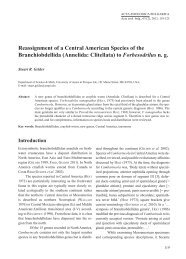
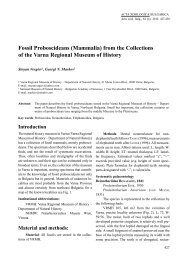
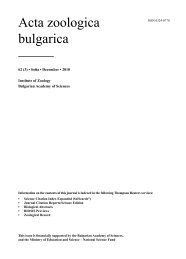
![table of contents [PDF] - Acta zoologica bulgarica](https://img.yumpu.com/52655254/1/186x260/table-of-contents-pdf-acta-zoologica-bulgarica.jpg?quality=85)
![table of contents [PDF] - Acta zoologica bulgarica](https://img.yumpu.com/52655255/1/186x260/table-of-contents-pdf-acta-zoologica-bulgarica.jpg?quality=85)
